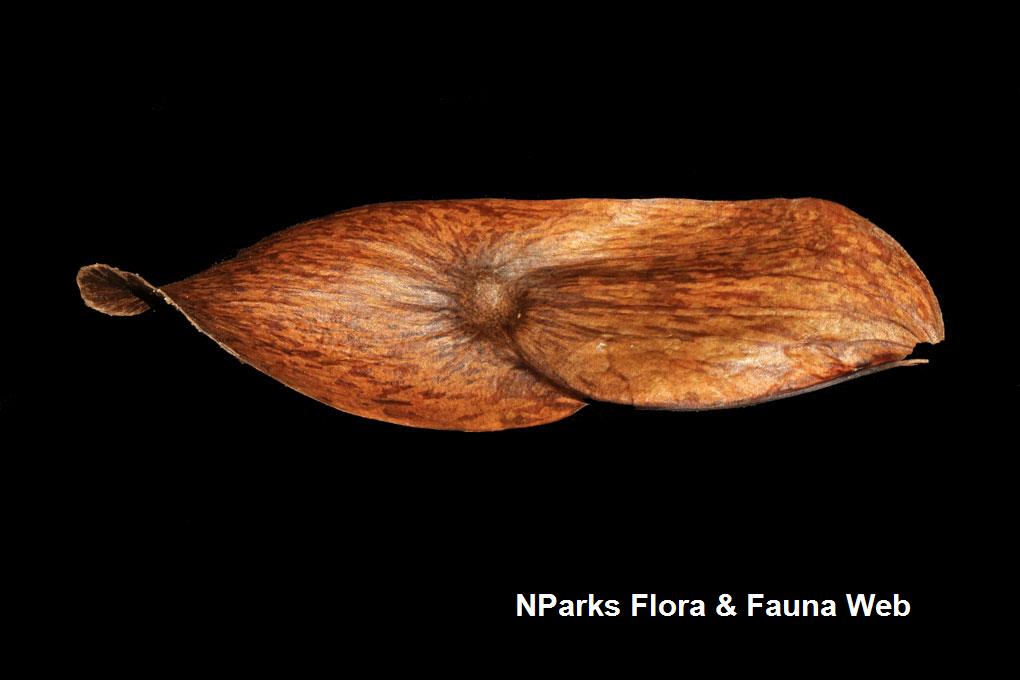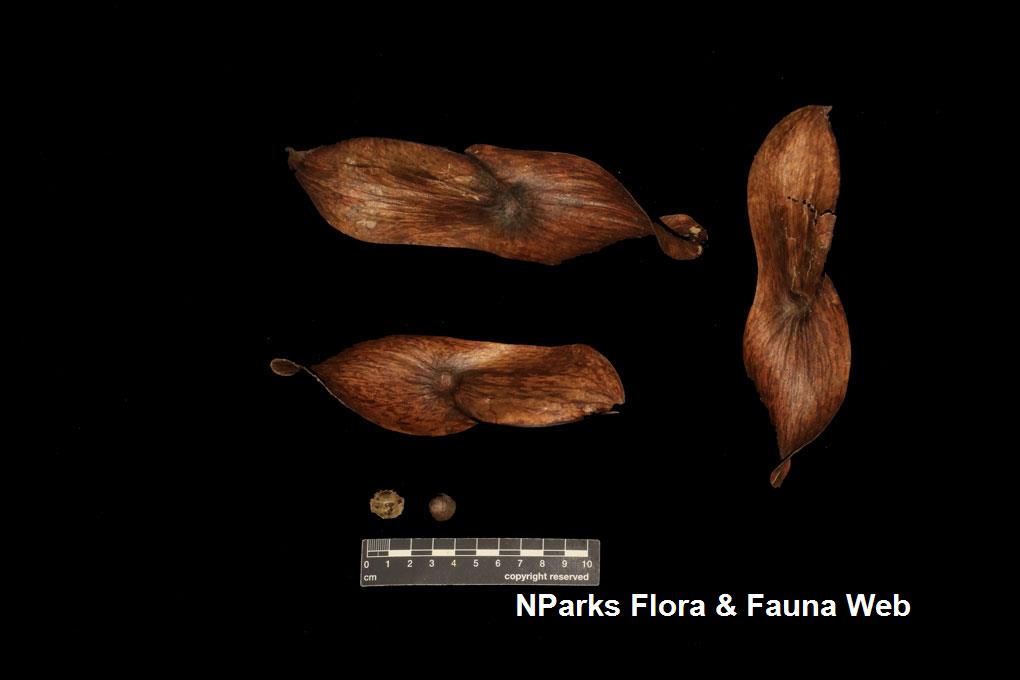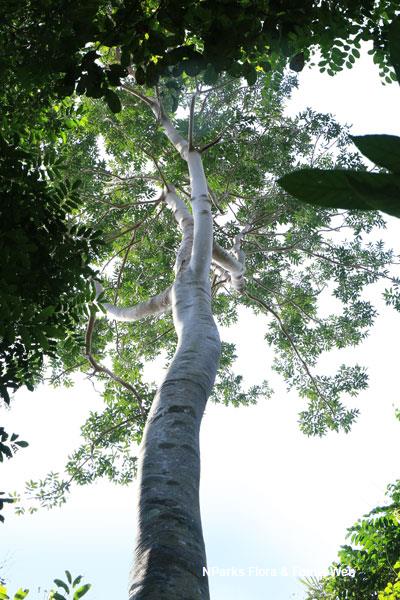
Back
Ailanthus integrifolia Lam.
| Family Name: | Simaroubaceae |
| Common Name: | White Siris |
Ailanthus integrifolia or White Siris is a tall tree native to Singapore. Growing to 60 m tall, it produce pinnate leaves with 2 - 9 pairs of leaflets, ovate to elliptic-oblong with a few black orbicular to oblong glands on the underside, near the base. Flowers are dioecious, borne on an inflorescence found along the axils. Flowers are greenish, 5-6 lobed and the male flowers said to carry an unpleasant odor. The fruit is an elliptic, dry, winged pod known as Samara covered in streaks or net-veins, held singly or in clusters.
Name
Classifications and Characteristics
| Plant Division | Angiosperms (Flowering Seed Plants) (Dicotyledon) |
|---|---|
| Plant Growth Form | Tree (Big (>30m)) |
| Maximum Height | 60 m |
Biogeography
| Native Distribution | Malesia, Melanesia and Singapore |
|---|---|
| Native Habitat | Terrestrial (Primary Rainforest, Secondary Rainforest) |
| Preferred Climate Zone | Tropical |
| Local Conservation Status | Native to Singapore (Critically Endangered (CR)) |
Description and Ethnobotany
| Growth Form | It is a tall tree with light brown to grey coloured bark that can grow to 60 m tall |
|---|---|
| Foliage | Leaves are 30 - 200 cm long held on an 5 - 20 cm stalk, pinnate with 2 - 9 pairs of leaflets. Leaflets are egg-shaped to broadly elliptic, often irregular to sickle-shaped, round tip with 6 - 13 pairs of lateral veins, measuring 10 - 40 cm long by 4 - 15 cm wide. Leaves have a few black orbicular to oblong glands on the underside, near the base. |
| Flowers | Flowers are dioecious where the male and female flowers are produced on separate individuals. Held on an 40 cm long or more inflorescence produced along the axils, flowers are in groups of 5 - 6. They are greenish, 5 - 6 lobed, petals are 9 mm long by 3 mm wide covered in short hairs. The male flowers are said to carry an unpleasant odour. |
| Fruit | The fruit is somewhat elliptic, single-winged, dry pod known as Samara covered in streaks or net-veins. The winged fruit is held singly or in clusters up to 5, measuring 11 - 22 cm long by 2.5 - 5 cm wide. |
| Habitat | Occurs commonly in primary rainforest, rarely found in secondary forest. From the lowland up to 900 m altitude <1,2> |
| Cultivation | It can be propagated by seed. |
| Etymology | The genus, Ailanthus derived from the Amboinese plant name aylanto, meaning tree of heaven, alluding to the lofty size of the Moluccan species. The species epithet, integrifolia Latin, integer meaning entire, folia meaning leaves or leaflets; the leaflet margins. |
Landscaping Features
| Landscape Uses | Parks & Gardens |
|---|
Plant Care and Propagation
| Light Preference | Full Sun |
|---|---|
| Water Preference | Moderate Water |
| Plant Growth Rate | Moderate |
| Propagation Method | Seed |
Foliar
| Foliage Retention | Evergreen |
|---|---|
| Mature Foliage Colour(s) | Green |
| Foliar Type | Compound (Even-Pinnate) |
| Foliar Arrangement Along Stem | Spiral |
| Foliar Attachment to Stem | Petiolate |
| Foliar Shape(s) | Non-Palm Foliage (Asymmetrical, Elliptical, Falcate / Curved, Oblong, Ovate) |
| Foliar Venation | Pinnate / Net |
| Foliar Margin | Entire |
| Foliar Apex - Tip | Acuminate, Obtuse |
| Foliar Base | Oblique / Asymmetrical |
Non - Foliar and Storage
| Stem Type & Modification | Woody |
|---|
Floral (Angiosperm)
| Flower & Plant Sexuality | Unisexual Flowers , Dioecious |
| Flower Colour(s) | Green |
|---|
| Flower Texture(s) | Hairy / Hirsute |
| Flower Grouping | Cluster / Inflorescence |
| Flower Location | Axillary |
| Flower Symmetry | Radial |
| Flowering Habit | Polycarpic |
Fruit, Seed and Spore
| Mature Fruit Colour(s) | Brown |
|---|---|
| Fruit Classification | Simple Fruit |
| Fruit Type | Indehiscent Dry Fruit , Samara |
References
| References | <1> Kulip, J. & Wong, K.M. (1995). Simaroubaceae. Tree Flora of Sabah and Sarawak, vol. 1, pp. 423-424. Kuala Lumpur: Forest Research Institute Malaysia. <2> Nooteboom, H.P. (1962). Ailanthus. Flora Malesiana, ser. 1, Seed Plants, vol. 6, pt. 2, pp. 218. Leiden: Rijksherbarium. |
|---|
Image Repository
Others
| Master ID | 32402 |
|---|---|
| Species ID | 6813 |
| Flora Disclaimer | The information in this website has been compiled from reliable sources, such as reference works on medicinal plants. It is not a substitute for medical advice or treatment and NParks does not purport to provide any medical advice. Readers should always consult his/her physician before using or consuming a plant for medicinal purposes. |



